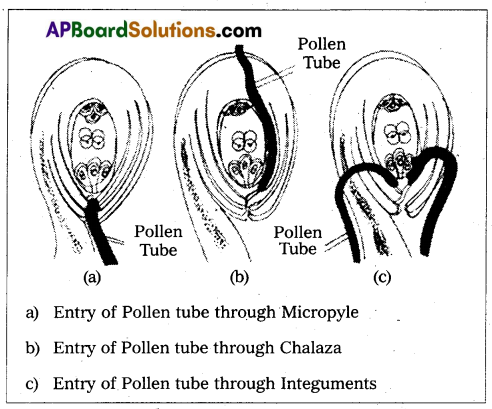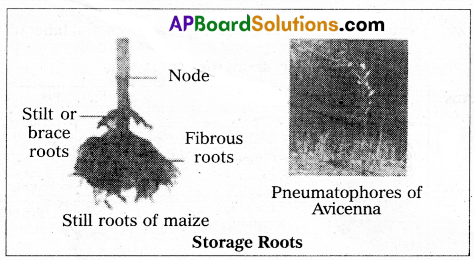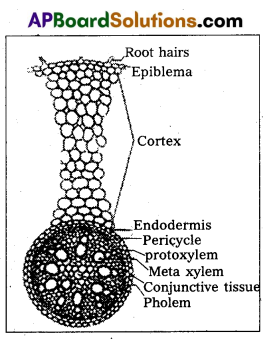Successful navigation through TS Inter 1st Year Botany Model Papers and TS Inter 1st Year Botany Question Paper March 2018 builds students’ confidence in their exam-taking abilities.
TS Inter 1st Year Botany Question Paper March 2018
Time: 3 Hours
Maximum Marks: 60
General Instructions:
Note : Read the following instructions carefully.
- Answer all questions of Section ‘A’. Answer any six questions out of eight in Section ‘B’ and answer any two questions out of three in Section – ‘C’.
- In Section ‘A’, questions from Sr. Nos. 1 to 10 are of “Very short answer type”. Each question carries two marks. Every answer may be limited to five lines. Answer all the questions at one place in the same order.
- In Section ‘B’, questions from Sr. Nos. 11 to 18 are of “Short answer type”. Each question carries four marks. Every answer may be limited to 20 lines.
- In Section ‘C’, questions from Sr. Nos. 19 to 21 are of “Long answer type”. Each question carries eight marks. Every answer may be limited to 60 lines.
- Draw labelled diagrams wherever necessary for questions in Section ‘B’ and C.
Section – A (10 × 2 = 20)
Note : Answer all questions. Each answer may be limited to 5 lines.
Question 1.
Who is popularly known as father of Botany ? What was the book written by him ?
Answer:
’Theophrastus” is regarded as the Father of Botany. He wrote a book “de Historia plantarum”.
Question 2.
What does ICBN stands for ?
Answer:
ICBN stands for International code for Botanical Nomenclature.
Question 3.
What does the term phycobiont and mycobiont signify ?
Answer:
The algal component in a lichen is called phycobiont and the fungal component in a lichen is called mycobiont.
![]()
Question 4.
Define placentation. Which placentation is seen in Dianthus?
Answer:
The arrangement of ovules within the ovary is known as placentation. In Dianthus free central placentation is seen.
Question 5.
Define venation. How do Dicots differ from Monocots with respect to venation ?
Answer:
The arrangement of veins and vein lets in the lamina is called venation. In Dicots Reticulate venation is seen {Net like arrangement of veins} where as in monocots – parallel venation is seen {Parallel arrangement of veins}.
Question 6.
Define Alpha taxonomy and omega taxonomy.
Answer:
Classification based on morphological characters is called alpha taxonomy. Classification based on information from other branches i.e., from Embryology, cytology, palynology, phytochemistry and serology along with morphological characters is called omega taxonomy.
Question 7.
Given that the average duplication time of E.coli is 20 minutes. How much time will two E.coli cells take to become 32 cells ?
Answer:
80 minutes.
Question 8.
Give one example for each of aminoacids, sugars, nucleotides and fatty acids.
Answer:
Amino acids : Glycine, Alanine .
Sugars : Cellulose, {Glucose, Ribose}
Nucleotides : Adenylic acid Fatty acids : Lecithin, Glycerol
Question 9.
In which phase of the cell cycle DNA synthesis occur ?
Answer:
Synthesis phase of Inter phase.
Question 10.
Define communities. Who classified communities into hydrophytes, mesophytes and xerophytes ?
Answer:
An assemblage of all the populations belonging to different species occur in an area is called community. Eugene Warming classified communities into three types.
![]()
Section – B (6 × 4 = 24)
Note : Answer any six questions. Each answer may be limited to 20 lines.
Question 11.
Give a brief account of Dinoflagellates.
Answer:
- Dinoflagellates are mostly marine and photosynthetic. They appear yellow green, brown, blue or red depending on the pigments in their cells.
- The cell wall has stiff cellulose plates on the outer surface.
- They have two flagella and produce spinning movements. So these protists are cailed “whirling ships”.
- The nucleus has condensed chromosomes which are without histones. This is called mesokaryon.
- Some dinoflagellates like Noctiluca show bioluminescene.
- Red dinoflagellates like Gonyaulax undergo rapid multiplication and make the sea appear red (Red tides in Medeterraniansea).
- Toxins produced by them may kill fishes.
Question 12.
What is meant by Homosporous and heterosporous pteridophytes ? Give two examples.
Answer:
The condition where only one type of spores are produced is called Homosporous pteridophytes.
Ex: Psilotum, Lycopodium
The condition where different types of spores are pro-duced is called Heterosporous pteridophytes.
Ex: Selagenella, Salvinia.
Question 13.
Discuss the various types of pollen tube entry into ovary with the help of diagrams.
Answer:
Pollen tube enters into the ovule from ovary by three ways.
They are
a) Porogamy : Pollen tube enters into the ovule through Micropyle. Ex : Ottelia, Hibiscus.
b) Chalazogamy : “Pollen tube enters into the ovule through Chalaza”. Ex: Casuarina.
c) Mesogamy : “Pollen tube enters into the ovule through the integuments”. Ex : Cucurbita.

Question 14.
Describe the non-essential floral parts of plants belonging to Fabaceae.
Answer:
In Fabaceae, the non-essential floral parts are Calyx and Corolla.
Calyx : Sepals 5, gamosepalous, valvate aestivation and odd sepal is anterior.
Corolla : Polypetalous, papilionaceous type consisting of large posterior petal called standard petal, two lateral petals called wings and the two anterior fused petals are called keel petals which enclose essential organs. They show descendingly imbricate aestivation.
![]()
Question 15.
Differentiate between Rough Endoplasmic Reticulum (RER) and Smooth Endoplasmic Reticulum (SER).
Answer:
| Rough Endoplasmic Reticulum | Smooth Endoplasmic Reticulum |
| 1) ER studded with ribosomes is called Rough ER. | 1) ER without ribosomes is called smooth ER. |
| 2) These are mainly composed of cisternae. | 2) These are mainly composed of tubules. |
| 3) They are associated with nuclear membrane. | 3) They are associated with plasma membrane. |
| 4) They mainly involved in Proteinsynthesis. | 4) They mainly involved in Lipid synthesis. |
Question 16.
Give a brief account of the types of chromosomes based on the position of Centromere.
Answer:

Basing on the position of the centromere, four types of chromosomes are recognised.
They are
- Metacentric : Centromere is present in between the two ‘ arms of the chromosome. It is V shaped and consists of two equal arms.
- Sub-Metacentric : Centromere is present slightly away from the midpoint of a chromosome. It is ‘L’ shaped and consists of two unequal arms.
- Acrocentric : Centromere is present at the sub terminal position of the chromosome. It appears ‘J’ shaped and consists of one long arm and one short arm.
- Telocentric : Centromere is present at the terminal posi-tion of the chromosome. It appears ‘I’ shaped and con-sists of one arm.
Question 17.
What is Periderm ? How does Periderm formation take place in the dicot stem ?
Answer:
Phellogen, Phellem and Phelloderm together called periderm. In Dicots, stem continues to increase in girth due to activity of vascular cambium. As a result, the other cortical cells and epidermal layers ruptures and need to be replaced to provide new pulective layers. Hence another meinstematic layer develops in the cortical region called cork cambium or phellogen. It is made up of narrow, thin walled cells which cuts of cells in both sides. The outer cells differentiates into work or phellem, while the Inner cells differentiates into secondary cortex or phellodym. The work in imperious to water due to subain deposition in the cell Nail. The secondary cortical cells are parenchymatous, Phellogen, Phellem and phellodlum are collectively known as puiderm.
Question 18.
Give a brief account on the classification of Xerophytes.
Answer:
Xerophytes are classified into three types.
They are :
- Ephemerals: These are annuals which complete their life cycle within a short period. Ex : Tribulus.
- Succulents : They absorb large quantities of water during rainy season and store it in different plant parts in the form of mucilage. As a result the plant parts become fleshy or succulent. The store water is used during dry periods. Ex: Stem succulents : Opuntia. Root succulents : Asparagus. Leaf succulents : Aloe.
- Non succulents: These are perennial plants can withstand prolonged period of drought. Ex : Casuarina.
![]()
Section – C (2 × 8 = 16)
Note : Answer any two questions. Each answer may be limited to 60 lines.
Question 19.
Define Root modification. Explain how root is modified to perform different functions ?
Answer:
A change in the normal structure of root to carry out new functions according to environment is called root modification.
Root Modifications : In some plants, roots change their shape and structure to perform functions other than absorption and conduction of water and minerals called root modifications.
They are of different types.
- In Carrot, turnip (Tap roots), Sweet potato (Adventitious roots), Asparagus (Fibrous roots) become swollen due to storage of food called storage roots.
- In Banyan tree, roots arise from the branches grow into the soil, become pillar like and give additional support called prop roots or pillar roots.
- In maize, sugarcane, roots arise from the lower nodes of the stem, give additional support called stilt roots.
- In Mangroves like Rhizophora and Avicennia, many roots come out of the ground and grow vertically upwards, help in respiration called Pneumatophores.
- In Epiphytes like Vanda, special adventitious roots arise help in absorption of moisture from atmosphere called Velamen roots.
- In partial parasites like viscum and strga, some Haustorial roots enter into xylem of the host plant to get water and minerals. In complete parasitic like cuscuta and Rafflesia, the haustorial roots enter into xylem and phloem of the host plant and obtain water and minerals and food materials called Parasitic roots.
- In the members of Fabaceae, the roots are inhabited by Rhizobium bacteria which helps in N2 fixation called Nodular roots.
- In some plants like Taeniophyllum, the roots are chloro phyllous and perform photosynthesis so called photo synthetic roots.



Question 20.
Draw the diagram of a Microsporangium and label its wall layers. Write briefly about the wall layers.
Answer:

A typical angiospermics anther is bilobed with each lobe having two theca. The anther is a four sided structure consisting of four microsporangia located at the comers, two in each lobe.
In a transverse section, a typical microsporangium is circular in out line and is surrounded by four wall layers, the (a) epidermis
(b) endothecium
(c) wall layers
(d) tapetum.
a) Epidermis : The epidermis is one celled thick, the cells present between the pollen sacs are th thin walled and their region is called as stomium which is useful for the dehiscence of pollen sacs.
b) Endothecium : It is present below the epidermis and expands radically with fibrous thickenings, at maturity these cells loose water and contract and help in. the dehiscence of pollen sacs.
c) Wall layers : Beneath the Endothecium, there are thin walled cells, arranged in one to five layers, which also help in dehiscence of Anther.
d) Tapetum : The innermost wall layer is Tapetum, the cells are large, with thin cell walls, abundant cytoplasm and have more than one nuclei. Tapetum is a nutritive tissue which nourishes the developing pollen grains.
![]()
Question 21.
Describe the internal structure of a Dicot root.
Answer:
A thin transverse section of dicot root shows three parts namely
i) Epidermis
ii) Cortex and
iii) Stele.
i) Epidermis: It is the outer most layers made of thin walled cells. Some cells protrude in the form of unicellular root hairs. So called Epiblema. It protects the inner parts. Root hairs help in absorption of water from the soil.
ii) Cortex : It consists of several layers of thin walled parenchyma cells with inter cellular spaces. The Innermost layer of cortex is called Endodermis. It comprises a single layer of barrel shaped cells without intercellular spaces. The tangential as well as the radial walls of Endoderm cells show suberin thickenings called casparian strips. Some cells opposite to protoxylem lack these strips called passage cells. They help in the movement of water and dissolved salts from cortex into xylem.
iii) Stele : It is the central part, consists of 4 layers.
a) Pericycle : It is single layered, made of thin walled parenchyma cells, present next to endodermis. It produces lateral roots and become vascular cambium during secondary growth.
b) Vascular Bundle : Xylem and phloem constitutes vascular Bundle. They are arr-anged on different radius (in alternate manner) so called Radial vascular Bun-dle, Xylem is exarch, where protoxylem is towards periphery and metaxylem is towards the center. Xylem is diarch to tetrarch condition. Xylem helps in conduction of water and minerals and phloem helps in conduction of food materials.

c) Medulla : It is absent or small, made of parenchyma cells. When present, it helps in the storage of food and water.
d) Conjunctive tissue : The parenchyma present between xylem and phloem is called conjunctive tissue which also involves in secondary growth.